My thoughts on chant rhythm (and a few other things)
-
Liquescents and initio debilis, both interpreted as "grace notes before the beat"(acciacatura, an appoggiatura that doesn't alter the duration of the note after it but takes some time of what came before).
In the oriscus I Iike to do uppermordent or turn and in strophas I like to do pulsed vibrato in the repercussion, in quilisma sometimes an uppermordent, sometimes a turn, sometimes a glissando with vibrato, the main difference between oriscus and quilisma is that quilisma is interpreted as a grace between two notes and oriscus as a note with length (short or long duration) and a ornamentation tied to it. Van Biezen proposes to make an appoggiatura/acciacatura in the upper border before the main tone, I think it's easier to do the pitch of the oriscus, quickly move to the upper pitch and then return to the pitch of the oriscus.
But these ornaments are optional in the melody (maybe with the exception of quilisma as a light passing tone), it depends on the choir and soloist.Thanked by 1OMagnumMysterium -
A rather literal transcription of the Graduale Novum into modern notation:
[see first image in following comment]
The same without slurs and word extensions, but with fermatas added:
[see second image in following comment]
I have used a slash through the notehead to indicated the oriscus.Thanked by 1Lincoln_Hein -
Corrected.
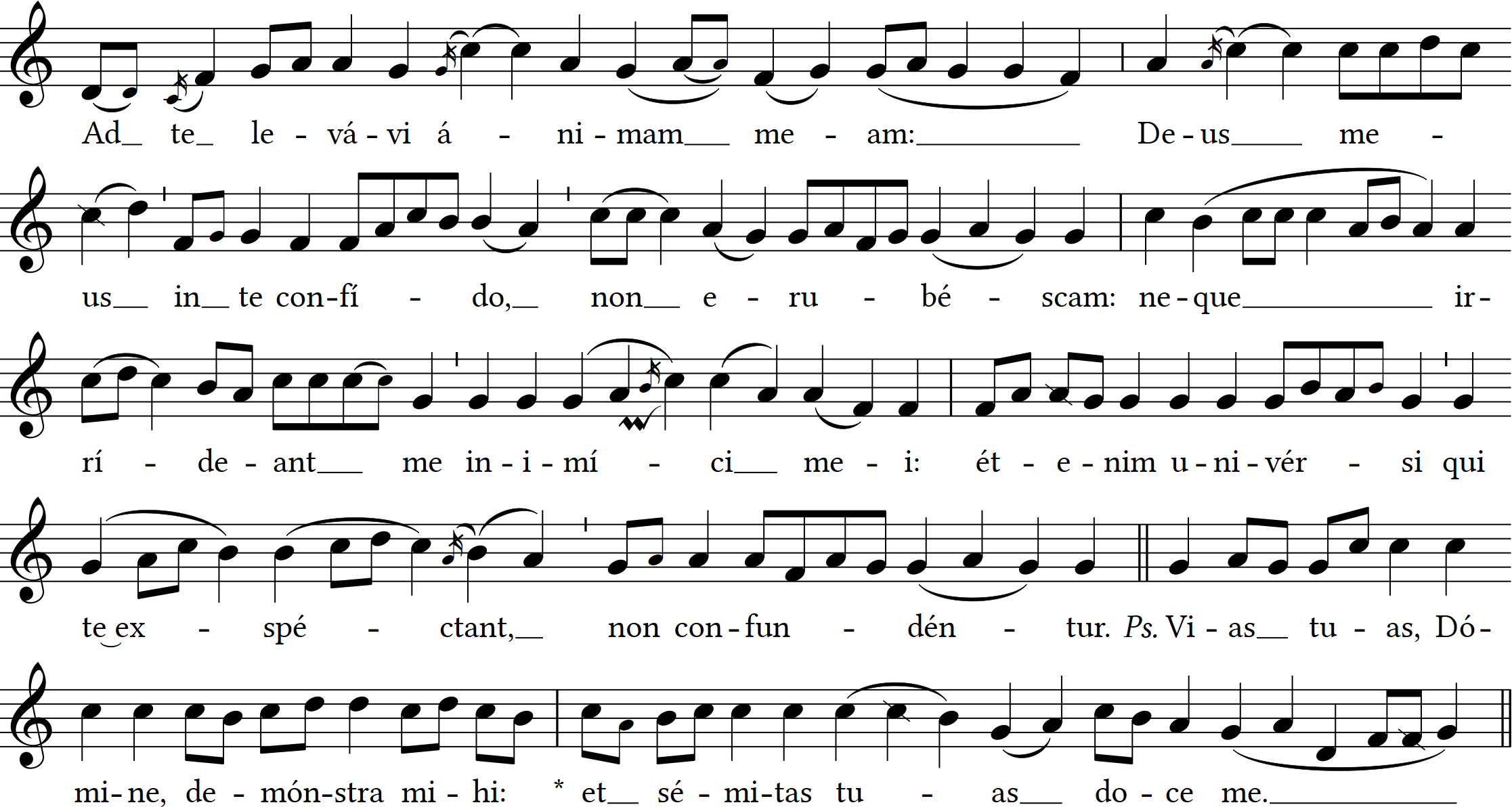
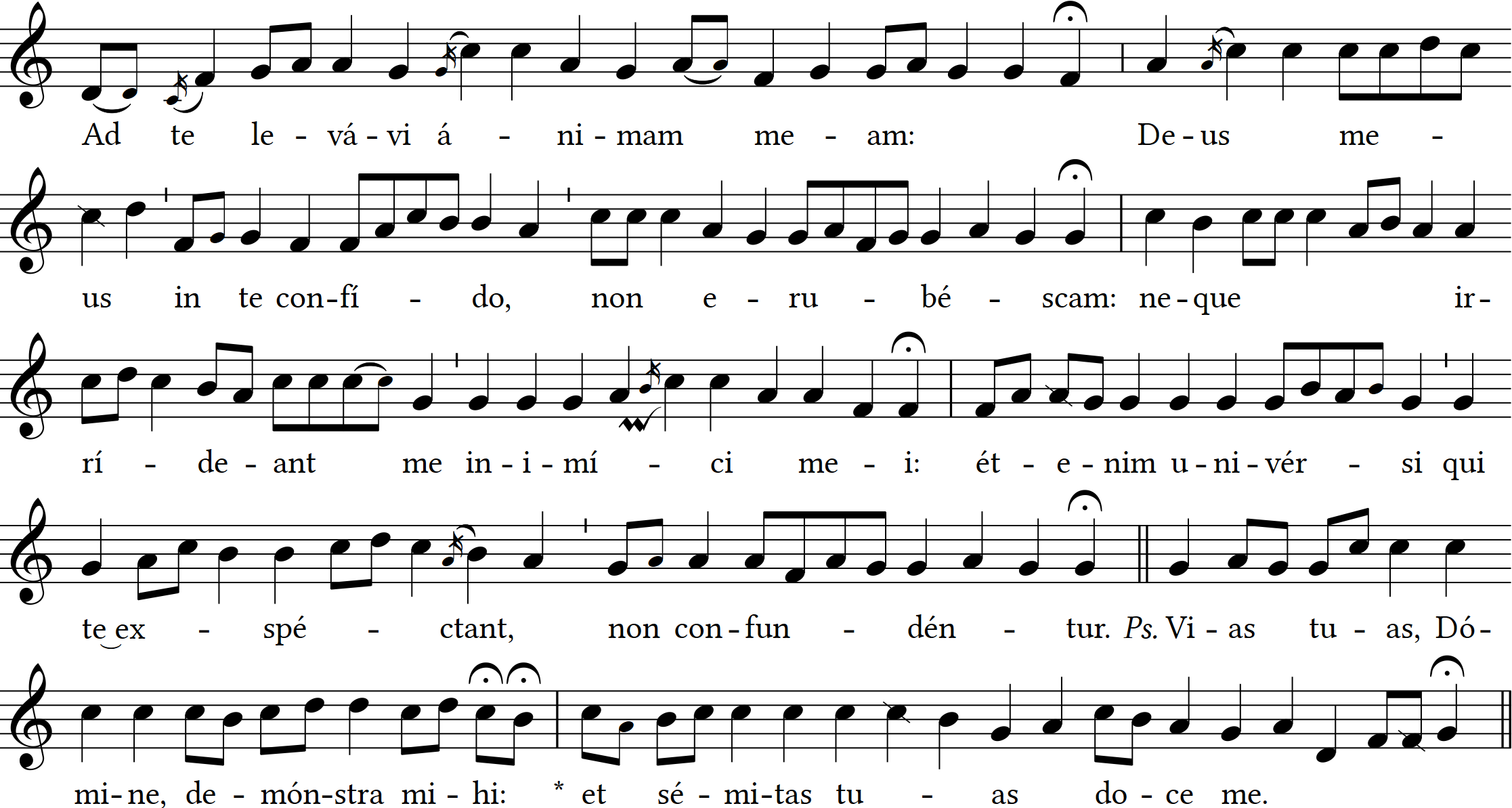

 In 8 Ad te levavi.png2233 x 1192 - 225K
In 8 Ad te levavi.png2233 x 1192 - 225K
 In 8 Ad te levavi ALT.png2233 x 1193 - 198K
In 8 Ad te levavi ALT.png2233 x 1193 - 198K -
For demonstrative purposes, someone else could interpret the same edition as follows:
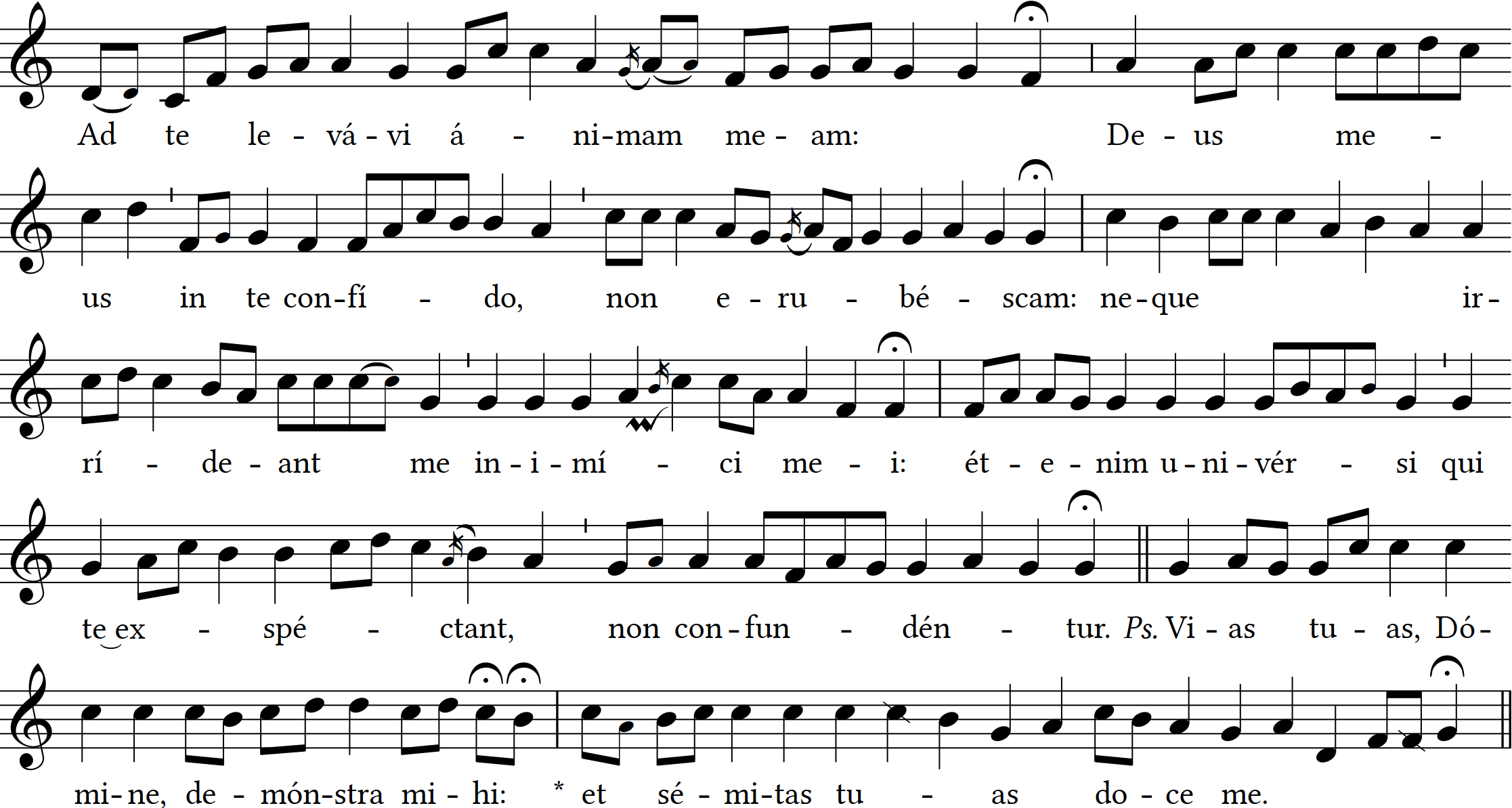

 In 8 Ad te levavi ALT2.png2233 x 1193 - 197KThanked by 1Lincoln_Hein
In 8 Ad te levavi ALT2.png2233 x 1193 - 197KThanked by 1Lincoln_Hein -
In the modern notation I don't like the "disconnectedness " with large spacing of the notes in the same syllable, when using quarter notes and eight notes and didn't like to use the slurs to do the connection. Because of this I proposed to use eighth note and sixteenth notes beamed together; and because the eight in the syllabic parts would be excessive in visuals with the stem and flag, I made only with notehead. The proportion between quarter and eight and eight and sixteenth is 2:1 so either could be used if the performer know that the tempo isn't too rush. Also the modern notation have the excessive consuming of horizontal space, it's this and the fact of the controversies about the interpretation of ornamental notes that made me try a hybrid: as if the square and the modern have a baby but with ornamental characteristics of the neumatic grandmother.Thanked by 1OMagnumMysterium
-
I'm still a little confused, so let me try to clarify my understanding about a couple of points.
1. What is going on with the neume on "Ad" at the very beginning? Are the downward slant of the punctum and the mini unison note in modern notation both trying to indicate something about the pronunciation of the d in Ad? I don't see what useful information is being conveyed which couldn't be shown adequately by a simple long note. In the case of two notation options, I would always take the simpler one unless there was justification for the contrary, but perhaps there's something I'm missing here.
2. Are the "mini notes" (grace notes or inition debilis, or whatever they are) supposed to be sung before or on the beat? I remember previously reading that all grace notes are sung before the beat, but maybe I'm incorrectly assuming all mini notes count as "grace notes" when really they don't. If there are differences in value, placement, or quality, between notes of lesser duration than a short, the notation needs to reflect that in a way clear enough to the average Joe (if I struggle to understand it, the average choir member probably will to). If these instances (te, animan, Deus) are two notes, which added together equal the duration of one long, I would highly suggest just writing two shorts unless there is compelling evidence for the contrary. I would say the simplest solution is the most likely, all else being equal.
3. I think the oriscus also needs a better explanation for the uninitiated. It needs to be clear where it is in the music and how it should be rendered. At the moment though I understand it to be a note which begins with a short grace note one step above (presumably on the beat), followed by the note of the written pitch. -
1. It's a unison liquescent note, what Cardine calls an augmentative liquescent. Yes, it is a diction reminder. Make sure the d is voiced so it doesn't get lost and come out as a te.
2. I recommend always before the beat, but this is a matter of interpretation. As I said, I included the alternative reading as two shorts for demonstrative purposes. To be as clear as possible: these transcriptions represent two possible interpretations of the same chant, not different ways of notating a single interpretation. The compelling evidence to the contrary lies in comparison of the sources. The uncinus at te is a single note. If the examples are to remain transcriptions of the Novum and not a new edition, the lower note can't disappear entirely.
3. If you're interpreting the oriscus as an upper auxiliary note, I again recommend a before-the-beat rendition. -
Last alterations I made in the hibrid notation (the tenutos are slight agogic nuance indicating some "punctuation" and maybe quick breath in some places):
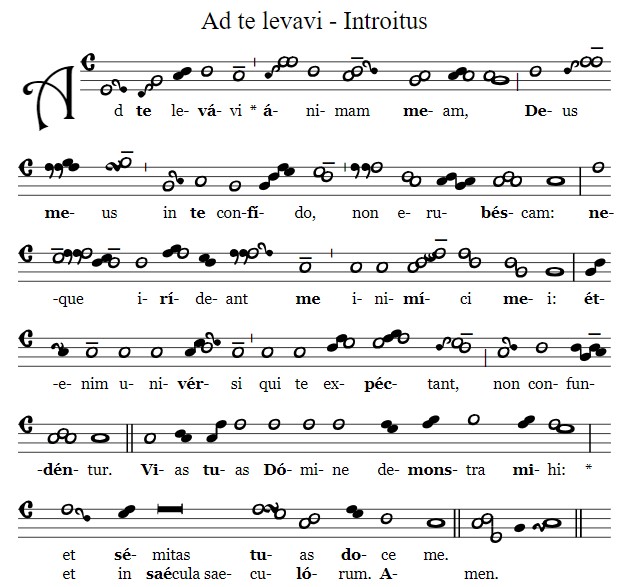

 hybrida.jpg621 x 587 - 97K
hybrida.jpg621 x 587 - 97K -
A follow-up posting to May 12 above: The Graduale Renovatum website now has a recording of the Gradual Liberasti nos from the 23rd Sunday after Pentecost, sung by the St. Blaise Schola Cantorum according to a semiological reading of the chant. The recording might be of interest to compare with the one posted above on Feb 3 demonstrating a proportionalist interpretation of the same chant.
www.gradualerenovatum.com
-
If I were a ninth-century copyist transcribing the St. Blaise Schola Cantorum performance, there are several places I would have to notate the chant differently from what appears in L and C. I have marked in red the notes where the recording (not necessarily the Graduale Renovatum) contradicts both L and C, and blue where it contradicts only L.
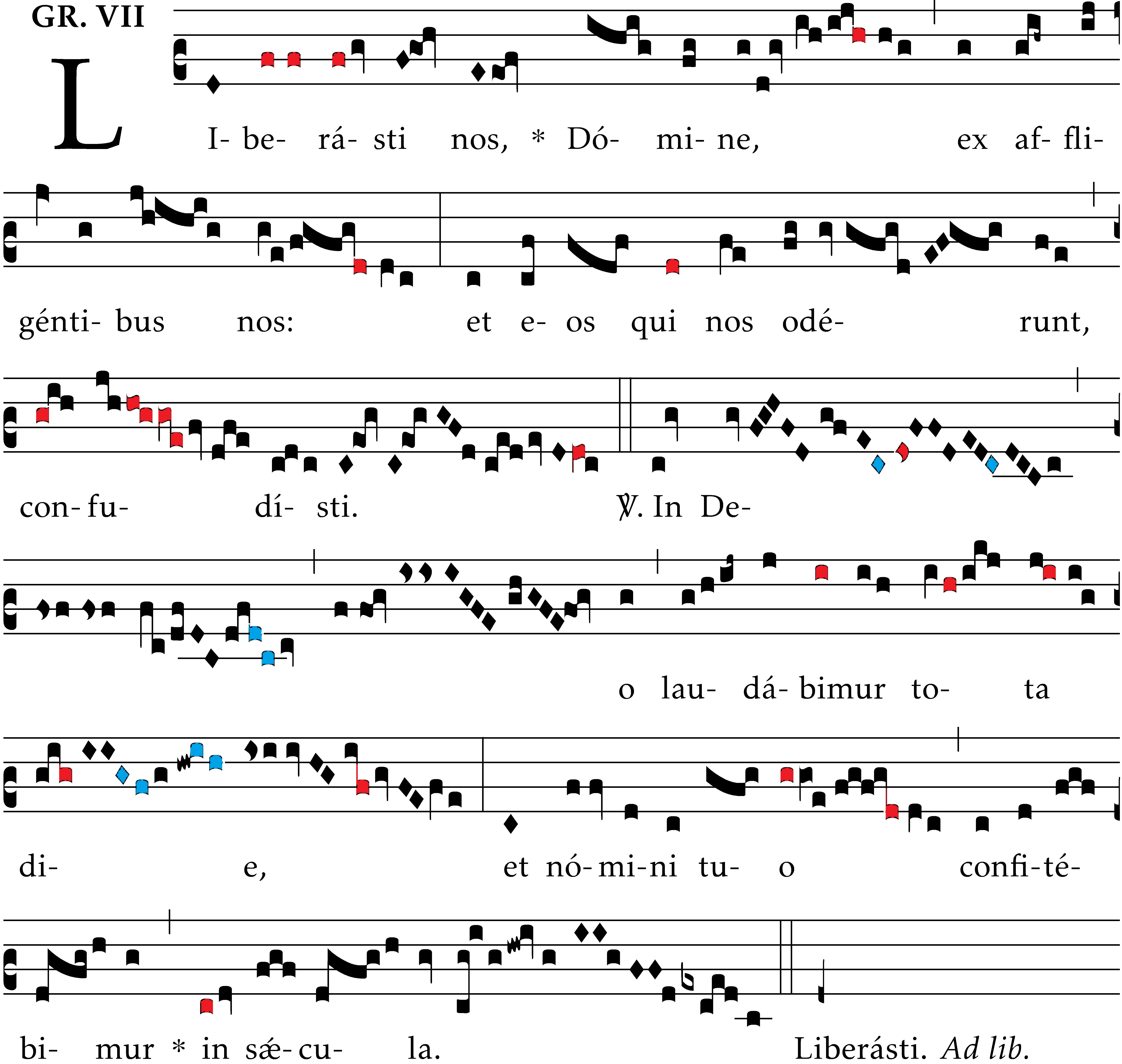
Certainly, there's room for interpretation, but I don't understand the singing of a note with an episema as short within a semiological hermeneutic. (For those reading, this is entirely separate from the issue of whether longs and shorts are in 2:1 proportion or not.) I also don't understand holding the first note of confudisti. I, too, interpret the cadential pressus major as long, but three longs, not one short plus two longs. I find the verse final on fa jarring when the respond isn't repeated.
This critique notwithstanding, I have personally found your site very useful, and I thank you for your work!
 Gr Liberasti.jpg6828 x 6476 - 2MThanked by 1Lincoln_Hein
Gr Liberasti.jpg6828 x 6476 - 2MThanked by 1Lincoln_Hein -
I spent some more time with this today. Based on the recording, I would expect the neumes in question to be notated like this:
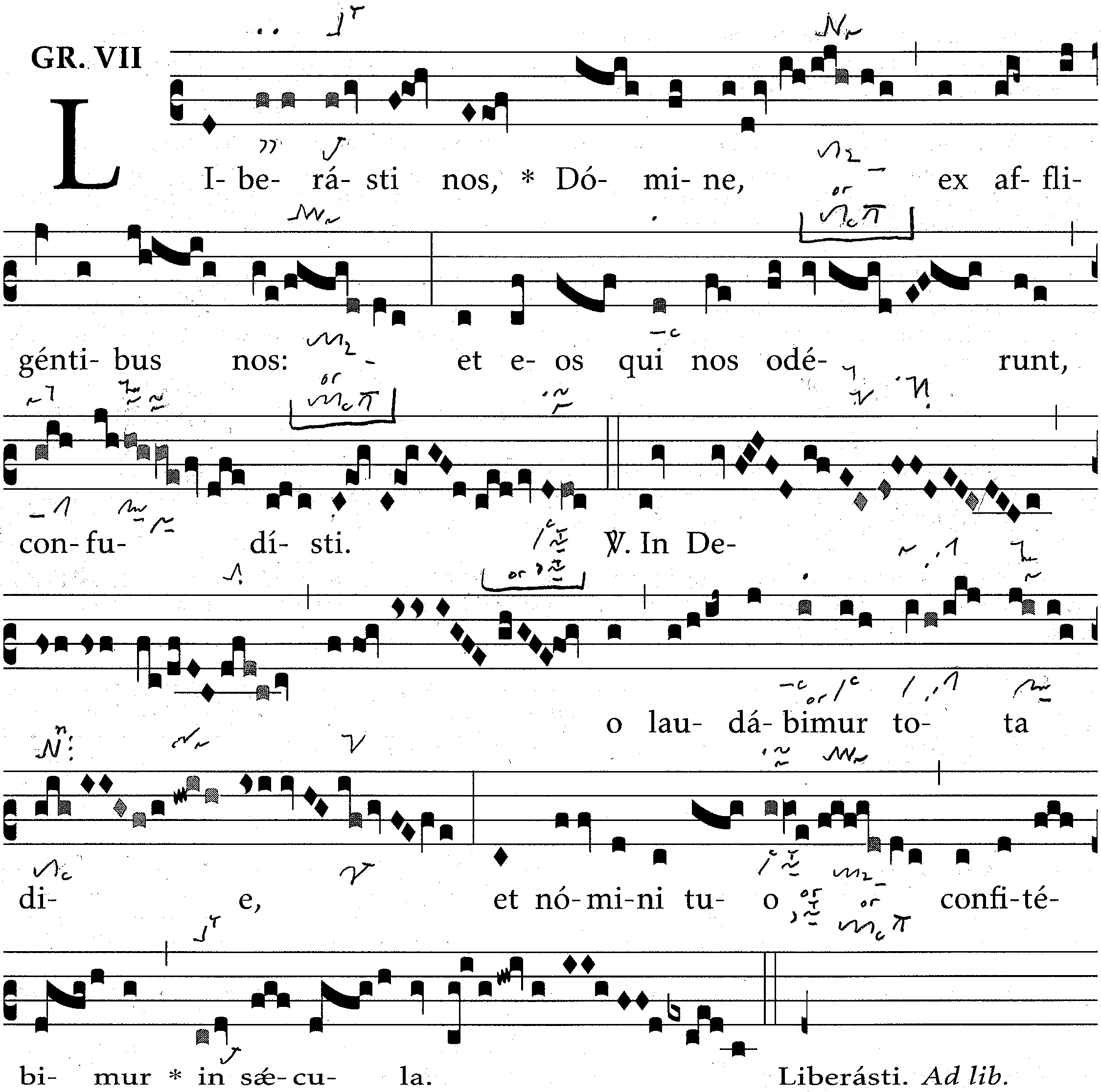
But they're not. Semiologists, what do you say? I count twelve instances of definite, unambiguous long markings being disregarded; the adiastematic neumes cannot be accurately reconstructed from the recording in those places. Now, if the rhythmic markings are only meant to indicate slight agogic nuances, I don't suppose it makes much of a difference, but if I believed that, I wouldn't have joined this discussion.
 Gr Liberasti.jpg2250 x 2232 - 871KThanked by 1Lincoln_Hein
Gr Liberasti.jpg2250 x 2232 - 871KThanked by 1Lincoln_Hein
Welcome to the MusicaSacra Forum!
To participate in the discussions on Catholic church music, sign in or register as a forum member, The forum is a project of the Church Music Association of America.
Categories
- All Discussions21,158
- General Music Discussion8,236
- Job Openings204
- Management of Music Programs850
- Choral Matters533
- Church Documents and Rubrics526
- CMAA Notes304
- Events720
- For Newcomers: Read First26
- Sacred Polyphony547
- Hymnody872
- Gregorian Chant: General2,702
- ↳ Graduale Romanum and Liber Usualis368
- ↳ Graduale Simplex60
- ↳ Semiology63
- Vernacular Plainsong696
- Anglican Use and Anglican Chant68
- Organ, Other Instruments and Repertoire435
- New Composition/Works in Progress1,295
- Recordings234
- Music for Hispanic Ministry159
- Music Education: Children211
- Music Education: General222
- News Items245
- Positions Wanted2
- General Discussion: Catholicism740
- Amusements177
- General Discussion1,035
- Opinions119
